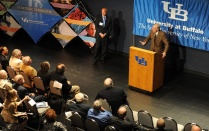Zhen Wang publishes work detailing cardiac glycosides in two foxglove species grown for medicinal purposes

Zhen Wang
Zhen Wang's lab is investigating the chemical processes the plants use to create cardiac glycosides: what steps are taken, what genes are turned on and what enzymes are deployed. Wang’s team can figure out, step by step, how foxgloves make cardiac glycosides, scientists could leverage that information to explore a variety of improvements.
“We can learn from nature,” Wang says. “We can study all of the available compounds that are found in the plants and then come up with our own design of compounds that are safer and more effective. That’s why I think it’s important to not just focus on the current drug digoxin, but to expand our focus to all the compounds in the same class, the cardiac glycosides.”
Read the full article by Charlotte Hsu.
Research News
Foxglove plants produce heart medicine. Can science do it better?

Digitalis lanata, grown in a greenhouse. This species of foxglove plant makes digoxin, a chemical that is used sparingly to treat heart failure.
By CHARLOTTE HSU
Published April 13, 2020 This content is archived.
Foxglove plants, found in many gardens, are known for the showers of bell-shaped flowers they produce.
But plants belonging to this genus, Digitalis, also harbor a less visible asset: chemicals called cardiac glycosides, which have been recorded to treat heart failure since the 1780s, says UB biologist Zhen Wang.
Wang’s research investigates how foxgloves create these medicinal compounds, with an eye toward improving the process. Farming foxgloves is time-consuming and labor-intensive, and Wang hopes to change that.
Specifically, her lab is investigating the chemical processes the plants use to create cardiac glycosides: what steps are taken, what genes are turned on and what enzymes are deployed.
“The reason why plants make so many natural products with medicinal properties is because they are also fighting diseases,” says Wang, assistant professor of biological sciences, College of Arts and Sciences. “Plants aren’t like animals. They can’t run away when stresses come, so they cope with this by becoming the most extraordinary chemists on the planet.”
And yet, “How plants synthesize many natural products is largely unknown,” she says. “I want to understand how we can harness the power of nature to make the process of producing medicinal compounds more efficient and sustainable. Foxgloves make these powerful compounds, but it takes two years to do so, and they don’t make them in a very large quantity. How can we improve this process?”
Studies illuminate chemical compounds
Wang’s team recently published a pair of papers detailing the characteristics of cardiac glycosides in two foxglove species: Digitalis purpurea, a showy purple flower found in many gardens, and Digitalis lanata, which is grown for medicinal purposes.

Digitalis purpurea, grown by UB biological sciences researcher Zhen Wang. This foxglove species is often grown as an ornamental plant in gardens, whereas its relative, Digitalis lanata, is often farmed for medicine production.
“This kind of study is important because we first have to know the accurate structure of natural compounds before we can explore their medicinal effects,” she says.
The first paper, published online in January in the Journal of Chromatography A, describes methods for assessing the exact mass and structure of cardiac glycosides, and compares compounds found in Digitalis purpurea and Digitalis lanata. The second study, published online in March in the journal Data in Brief, expands on the first, providing additional data on characteristics of cardiac glycosides in both species.
“When we looked at the cardiac glycosides in each of them, we found drastic differences,” Wang says. “In the industrial strain that’s grown for medicine, you see much higher amounts of cardiac glycosides, with much more diversity. I think this just highlights the adaptation of plants and how versatile they are as chemists.”
Both studies included contributions from researchers in the UB Department of Chemistry.

Digitalis lanata seedlings, grown in a greenhouse. This species of foxglove plant makes digoxin, a chemical that is used sparingly to treat heart failure.
Improving on foxglove’s natural skills
Digitalis lanata is cultivated for medicine because it makes a cardiac glycoside called digoxin. This compound is toxic in large quantities, but it’s prescribed sparingly, in small doses, to treat heart failure and certain heart rhythm abnormalities.
Current methods for producing digoxin are cumbersome: Because each foxglove plant makes only a little bit of the chemical, farmers must grow the crop in huge quantities, Wang says. That uses up a lot of agricultural land. The wait time is also long.
“It takes two years, from the time you plant the seed to the time the leaves are ready to harvest, and then you have to dry it in the silo,” she says. “Then, the plant is crushed into powder, and the compound is extracted and purified using chemical processes.”
If Wang’s team can figure out, step by step, how foxgloves make cardiac glycosides, scientists could leverage that information to explore a variety of improvements.
Biologists could engineer fast-growing microbes, such as yeast or harmless strains of bacteria, to produce cardiac glycosides more quickly. Plant scientists could genetically engineer foxgloves to make larger amounts of digoxin, which would increase the efficiency of farms and free up land for other useful crops.
Medicinal chemists could also work to develop new drugs that are similar to digoxin but safer.
“We can learn from nature,” Wang says. “We can study all of the available compounds that are found in the plants and then come up with our own design of compounds that are safer and more effective. That’s why I think it’s important to not just focus on the current drug digoxin, but to expand our focus to all the compounds in the same class, the cardiac glycosides.”
Faculty Profile

Zhen Q. Wang
PhD
Research Interests
Synthetic biology and plant natural products
Education
- PhD, Michigan State University
- Postdoctoral Research, University of California, Berkeley
Research Summary
Healing with medicinal plants is as old as humankind itself. Even today, some of the most extensively used drugs such as aspirin, morphine, and quinine are directly extracted from plants. Unlike synthetic drugs, plant natural products are evolutionarily pre-selected chemicals against a wide spectrum of pathogens and other stresses in the environment. However, most plant-based medicines, although biologically effective, have not entered the realm of modern medicine. The biggest challenge is the lack of effective and sustainable methods for producing plant-based medicines because they are present at extremely low concentrations, sometimes less than 0.0001% of fresh weight. The current strategy of farming host plants is unlikely to meet the increasing demand for plant-derived drugs. In addition, these natural products usually have complex chemical structures, and conventional drug synthesis has not been able to produce them in a cost-effective manner.
The long-term goal in my laboratory is to provide alternative solutions for the sustainable and economical production of plant-based medicines through metabolic engineering and synthetic biology. In particular, we build novel metabolic pathways and reroute native pathways in microorganisms such as E. coli and yeast for the production of plant-derived drugs. Our current focus is terpene, the largest family of plant natural products. Many essential medicines including anti-cancer drug paclitaxel, vinblastine, and vincristine, are terpenes or terpene derivatives. Moreover, a complete understanding of biosynthesis pathways in host plants precedes any engineering efforts for scalable production of plant-based medicines. To this end, we are investigating the missing genes in the biosynthesis of digoxin—an important medicine on the World Health Organization’s (WHO) list of essential medicines for the treatment of heart failure. With the unprecedented technological advancement including DNA synthesis, -omics tools, and genome editing in recent years, we hope to tap into the great diversity of plant natural products to benefit the human health."
Selected Publications
- Carroll, E., Ravi Gopal, B., Raghavan, I., Wang, Z.Q*. The P450 CYP87A4 imparts sterol side-chain cleavage in digoxin biosynthesis. Nature Communications. 14: 4042 (2023). (Link)
- Mukherjee, M., Blair, R., Wang, Z.Q.* Machine-learning guided elucidation of contribution of individual steps in the mevalonate pathway and construction of a yeast platform strain for terpenoid production. Metabolic Engineering . 74:139-149 (2022). (Link)
- Raghavan, I., Ravi Gopal, B., Carroll, E., Wang, Z.Q.* Cardenolide increase in foxglove after 2,1,3-benzothiadiazole treatment reveals a potential link between cardenolide and phytosterol biosynthesis. Plant and Cell Physiology. pcac144 (2022). (Link)
- Mukherjee, M., Wang, Z.Q.* A Well-characterized polycistronic-like gene expression system in yeast. Biotechnology and Bioengineering. 120(1):260-271 (2022). (Link)
- Wang, Z.Q., Song, H., Koleski, E.J. et al. A dual cellular–heterogeneous catalyst strategy for the production of olefins from glucose. Nat. Chem. 13, 1178–1185 (2021). (Link)
- Mukherjee, M., Carroll, E., Wang, Z.Q.*, Rapid assembly of multi-gene constructs using modular Golden Gate cloning. Journal of Visualized Experiments. Feb. 2021. 168: e61993 (link)
- Swayambhu, G., Raghavan, I., Ravi, B.G., Pfeifer, B.A.*, Wang, Z.Q.* Salicylate glucoside as a non-toxic plant protectant alternative to salicylic acid. ACS Agricultural Science and Technology, Aug. 2021. (link)
- Ravi Gopal, B., Guardian, M.G., Dickman, R., Wang, Z.Q.*, High-resolution tandem mass spectrometry dataset reveals fragmentation patterns of cardiac glycosides in leaves of the foxglove plants. Data Brief 2020; 30;105464 (Link)
- Ravi Gopal, B., Guardian, M.G., Dickman, R., Wang, Z.Q.*, Profiling and structural analysis of cardiac glycosides in two species of Digitalis using high-resolution tandem mass spectrometry. J. Chromatography A, 2020; 1618; 460903 (Link)
- Wang, Z., Benning, C. Specific Detection and Quantification of Phosphatidic Acid Using the Arabidopsis TGD4 Protein. S. Patent 8,629,251 B2, 2014 (link)
- Wang, Z., Anderson, N.S., Benning, C. The Phosphatidic Acid Binding Site of the Arabidopsis TGD4 Protein Required for Lipid Import into Chloroplasts Journal of Biological Chemistry 2013; 228(7); 4763-4771 (pdf)
- Wang, Z., Benning, C. Chloroplast Lipid Synthesis and Lipid Trafficking Through ER-to-Plastid Membrane Contact Sites. Biochemistry Society Transactions 2012; 40(2): 457-63 (pdf)
- Wang, Z., Xu, C., Benning, C. TGD4 Involved in ER-to-Chloroplast Lipid Trafficking is a Phosphatidic Acid Binding Protein. The Plant Journal 2012; 70(4): 614-623 (pdf)
- Wang, Z., Benning, C. Arabidopsis thaliana Polar Glycerolipid Profiling by Thin Layer Chromatography (TLC) Coupled with Gas-Liquid Chromatography (GLC) Journal of Visualized Experiments e2518 (pdf)
- Roston, R., Moellering E.R., Gao, J, Wang, Z., Muthan, B., Benning, C. Membrane Lipid Metabolism and Trafficking during Chloroplast Development and Maintenance Chemistry and Physics of Lipids 2010; 163; S16 (pdf)

